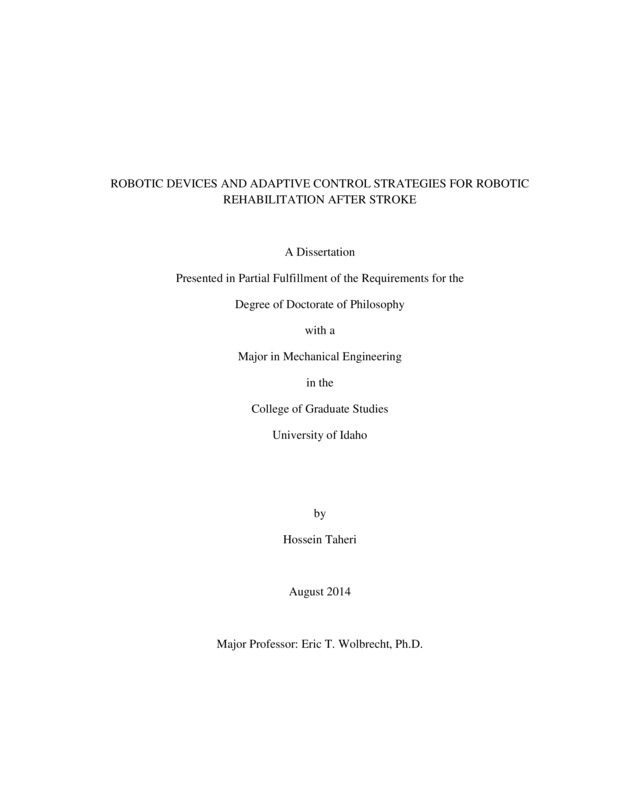ROBOTIC DEVICES AND ADAPTIVE CONTROL STRATEGIES FOR ROBOTIC REHABILITATION AFTER STROKE
Taheri, Hossein. (2014). ROBOTIC DEVICES AND ADAPTIVE CONTROL STRATEGIES FOR ROBOTIC REHABILITATION AFTER STROKE. Theses and Dissertations Collection, University of Idaho Library Digital Collections. https://www.lib.uidaho.edu/digital/etd/items/taheri_idaho_0089e_10386.html
- Title:
- ROBOTIC DEVICES AND ADAPTIVE CONTROL STRATEGIES FOR ROBOTIC REHABILITATION AFTER STROKE
- Author:
- Taheri, Hossein
- Date:
- 2014
- Embargo Remove Date:
- 2016-07-18
- Keywords:
- Adaptive Control Rehabilitation Robotics Stroke
- Program:
- Mechanical Engineering
- Subject Category:
- Robotics
- Abstract:
-
Stroke is the leading cause of neurological disability in the US and stroke patients typically require an extensive rehabilitation therapy to regain some of their lost neuromuscular functionality. Various robotic devices have been developed for post-stoke rehabilitation to reduce the labor intensity of therapists and rehabilitation cost and provide therapists with quantitative information about rehabilitation procedure and patients recovery. The robot-patient interaction plays an important role in effectiveness of robotic therapy. Different strategies have therefore been proposed and employed to control rehabilitation robots in order to improve the therapy outcome. However, since the underlying neural mechanisms of motor recovery after stroke are not completely understood, and the effect of each stroke is unique and can be very different from that of other strokes, it is not clear what control strategy is the best.
Adaptive assist-as-needed (AAN) control is a movement training methodology with very desirable characteristics for rehabilitation robotic applications. It can adaptively modulate the level of robotic assistance to promote patient active involvement in therapy.
In this research, the evolution of two robotic devices for stroke rehabilitation is presented. The FINGER (Finger Individuating Grasp Exercise Robot) rehabilitation robot was designed to assist with hand and finger rehabilitation. A discrete performance-based adaptive control was implementer on FINGER that could provide patients with a suitable assistance level in order to modulate success during therapy game play. In a separate experiment, an inertial and directionally dependent AAN controller was implemented and tested on the FINGER robot.
Additionally, the design and development of a 4-DOF parallel robot for upper extremity impairment rehabilitation is presented. This end-effector type rehabilitation robot has low end-effector inertia, is very backdrivable, and is designed to counter-balance a significant portion of its own weight in order to reduce the need for the robot's actuators to overcome gravitational forces. Finally, an inertial adaptive AAN controller is proposed and tested using dynamic simulations.
- Description:
- doctoral, Ph.D., Mechanical Engineering -- University of Idaho - College of Graduate Studies, 2014
- Major Professor:
- Wolbrecht, Eric
- Committee:
- Anderson, Michael; Assefi, Touraj; Riley, Matthew
- Defense Date:
- 2014
- Identifier:
- Taheri_idaho_0089E_10386
- Type:
- Text
- Format Original:
- Format:
- application/pdf
- Rights:
- In Copyright - Educational Use Permitted. For more information, please contact University of Idaho Library Special Collections and Archives Department at libspec@uidaho.edu.
- Standardized Rights:
- http://rightsstatements.org/vocab/InC-EDU/1.0/

